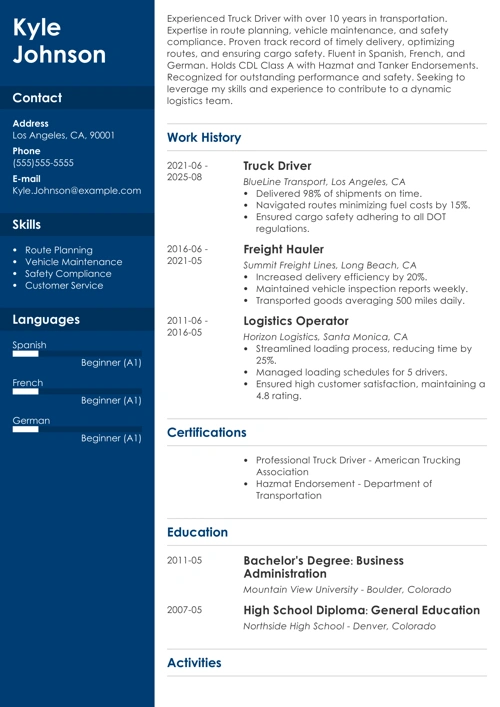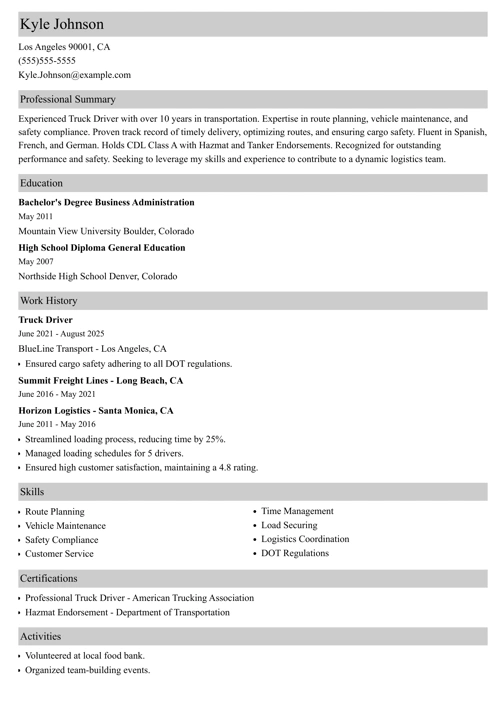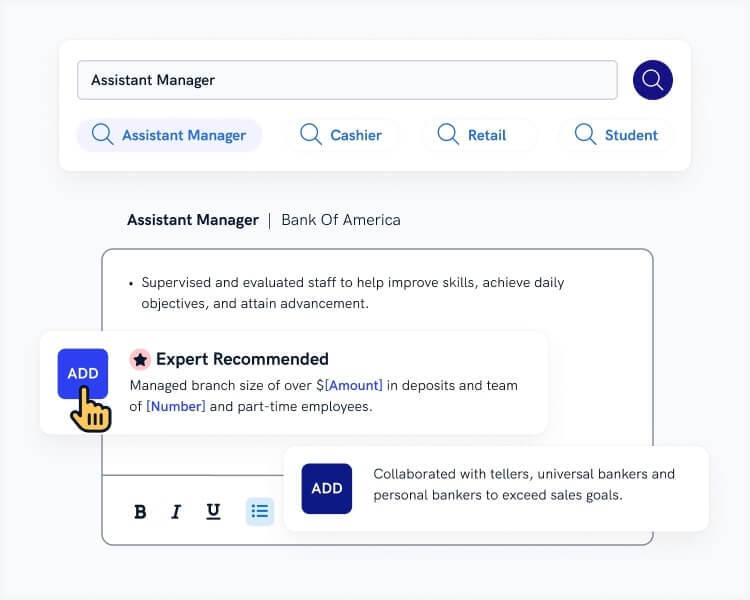You're about to write a killer truck driver resume. But first, think about this… There's a truck driver shortage. You can fog a windshield with your breath and get a job. Right?
Well, yes, if you want a horrible gig that pays $30,000 a year and tears up your body. But you want a job with great pay and great perks. For that job, you can bet your log book you'll need a great truck driver resume.
This guide will show you:
- A truck driver resume example better than 9 out of 10 other resumes.
- How to write a truck driver resume that will land you more interviews.
- Tips and examples of how to put skills and achievements on a truck driver resume.
- How to describe your experience on a resume for a truck driver to get any job you want.
Want to save time and have your resume ready in 5 minutes? Try our AI resume builder. It’s fast and easy to use. Plus, you’ll get ready-made content to add with one click. See 20+ resume templates and create your resume here.
Sample Truck Driver Resume—See more resume samples here.
Considering other jobs in travel & transportation? Perhaps one of these guides will interest you too:
- Bus Driver Resume
- Delivery Driver Resume
- Dispatcher Resume
- Driver Resume
- School Bus Driver Resume
- Logistics Coordinator Resume
- Logistics Manager Resume
- Logistics Resume
- Uber Driver Resume
- Forklift Operator Resume
- UPS Resume
Still need more examples? Check Sample Resumes to Land Any Job.
Truck Driver Resume Sample
Kyle Johnson
Truck Driver
+1 (123) 456-7890
kyle.johnson@email.com
linkedin.com/in/kyle.johnson
Summary
Diligent and detail-oriented Truck Driver with 10+ years of experience in the transportation industry. Ready to leverage strong problem-solving abilities, organizational skills, and customer service proficiency to ensure smooth deliveries for Swift Logistics’ customers. Achieved the highest customer satisfaction rating in the region while working at Star Carriers by delivering products on time on 98% of occasions.
Experience
Long Haul Truck Driver
Star Carriers, Provo, UT
November 2012–Present
Key Qualifications & Responsibilities
- Operate Class A commercial vehicles over long distances of up to 500 miles per day.
- Maintain accurate log books and records in compliance with federal regulations.
- Conduct daily vehicle inspections including tire pressure, fluid levels, brakes, lights, steering systems, etc.
- Ensure timely delivery of cargo with complete accuracy according to customer requirements.
- Handle loading/unloading of freight from trailers using proper lifting techniques and equipment.
- Complete all necessary paperwork accurately and on time such as shipment documents, invoices, mileage logs, etc.
Key Achievements:
- Delivered products on time on 98% of occasions.
- Achieved an average score of over 95% on all weekly performance reviews
Delivery Driver
Dynamo Innovations, Provo UT
June 2009–November 2012
Key Qualifications & Responsibilities
- Delivered products on time within assigned routes throughout Utah in a safe and efficient manner.
- Developed relationships with clients by providing exceptional customer service.
- Loaded/unloaded product safely onto trucks weighing up to 10 tons.
- Managed inventory control by properly tracking merchandise during the delivery process.
- Identified potential risks or areas for improvement pertaining to procedures or operations.
Key Achievement:
- Received Perfect Score Award from 6 out of 8 clients for delivering 100% accurate orders each month over the course of 2 years.
Education
High School Diploma
Timpanogos High School , Orem UT
August 2006–May 2009
Relevant Extracurricular Activities
- Volunteered at a local food kitchen assisting in meal distribution.
Academic Achievements:
- Graduated top 5 percentile of class.
Skills
- Strong knowledge of DOT rules & regulations
- Excellent navigational & route planning abilities
- Ability to lift heavy loads up to 50 lbs regularly
- Proficient in Microsoft Office Suite applications
- knowledgeable about customer service techniques
Certifications
- Commercial Driver’s License (Class A), State of Utah, 2009
- First Aid/CPR/AED certification, American Red Cross, 2010
Awards
- Accident Free Driving Award, Star Carriers, 2011
Memberships
- Member of American Truck Association since 2010
Languages
- English - Native
- Spanish - Intermediate
Interests
- Weightlifting - Competed in 3 local Powerlifting competitions.
- Vehicle Maintenance & Repair - Worked on upgrading 10 trucks with new parts.
1. What's the Best Format for a Truck Driver Resume?
Meet the hiring manager, Ken. He's got ten Hess Trucks in his office, but he can't see them over that stack of 300+ truck driving resumes. By the time he gets to yours, he's so bleary he can hardly read it.
The best truck driver resume format will grab his attention like an air horn.
The reverse-chronological driver resume format does that. How? By shortcutting right to the important info. It lists your last job first.
To make it easy for Ken to see your best side, use clear, legible fonts and big, friendly headings. Use white space too, to give his eyes a rest.
Finally, save your resume as a PDF. Truck driver resume PDFs preserve their formatting when you send them. MS word resumes can scramble in transit.
Pro Tip: Does the company accept commercial truck driver resume PDFs? If the job description doesn't ban them, that's a green light. Just make sure to check.
Want to explore other formats for a resume for truck drivers? See our guide: "3 Best Resume Formats: How to Choose the Right One [Examples]"
2. How to Write a Truck Driver Resume Objective or Resume Summary
Remember our hiring manager, Ken? After 298 trucker resumes, he's as tired as an OTR trucker on the last leg of an 11-hour shift.
You need to convince him you're the one to hire, and fast.
That means no piles of words to roadblock him. Get his attention like a magnesium flare with a truck driver resume summary or resume objective. Think of them as hooks.
A resume summary proves your worth by showing your accomplishments. It's for truck drivers hauling plenty of experience.
A truck driver resume objective statement shows your passion for the job. Use it if you're deadhead.
Need examples?
Truck Driver Resume Examples: Summary Statements
Check out the two very different commercial driver's license (CDL) truck driver resume examples below:
| right |
|---|
Dependable CDL-A OTR Truck Driver with 5+ years experience. Seeking to use proven reliability to deliver on time with high satisfaction for J.B. Hunt's customers. 100% clean driving record and drug test history. 97%+ customer satisfaction history with 11 management commendations. |
| wrong |
|---|
OTR Truck Driver with 5 years experience driving over the road and 1 year experience driving dump trucks. I have my CDL. I have amazing truck driving skills in OTR driving and vehicle maintenance. |
Those are as different as a speed trap and a truckstop.
That first OTR truck driver resume example is packed full of measurable, professional resume achievements. It'll land a CDL Class A driver job.
With the second CDL resume, you couldn't get a job hauling peanuts to Georgia.
Making a resume with our builder is incredibly simple. Follow our step-by-step guide, use ready-made content tailored to your job and have a resume ready in minutes.
When you’re done, our AI resume builder will score your resume and our resume checker will show you exactly how to improve it.
Don't have that kind of experience? Well, time for a resume without experience. But you can't add a summary then...
No worries. Use a truck driver resume objective.
Two Entry Level Truck Driver Resume Examples
A resume objective shows your passion for the job opening. It gets you hired from sheer grit, with no truck driver experience.
But here's a trick. You should still put some impressive hooks in it.
| right |
|---|
Hard-working CDL-A truck driver with proven skills in vehicle maintenance and problem solving. As dump-truck-driver for Blue Rock Stone, performed physically demanding work. My vehicle inspection and maintenance skills caught and fixed a safety issue that averted a potential catastrophe and earned a management commendation. |
| wrong |
|---|
Truck driver. No experience yet but I'm eager to start OTR work soon. |
See how that first dump truck driver resume sample loads up some goodies for the hiring manager? This works for delivery truck drivers too.
A CDL license is a big perk. That ATA membership helps, too. Between the two, you'll wake the hiring manager up like an in-cab ionizer.
Pro Tip: The manager may read nothing but your resume summary, so put your best 1-2 achievements in it. It's the only way to keep him reading.
For more resume tips, see the sample truck driver resume template at the top. Plus see these guides: How To Write A Resume Summary: 21 Best Examples You Will See AND +20 Resume Objective Examples - Use Them on Your Resume (Tips)
3. How to Describe Your Truck Driver Experience on a Resume
"I'll pay this guy whatever he wants."
Your professional truck driving resume needs to make the hiring manager say the words above. You don't need experience to fill just any old truck driver job description. But a resume for a truck driver without experience will default to the lowest paying work.
How you show it matters most.
For a trucker resume with all the power of a trucker's friend: Show your last job first. Under it, list 4-6 bullet points. Cram them with measurable accomplishments that fit this job opening.
Don't be generic.
Cookie-cutter resumes make great packing material. They're not good for much else.
CDL Truck Driver Resume Examples
| right |
|---|
CDL-A OTR Truck Driver Schneider National 2013 - 2017
|
| wrong |
|---|
CDL-A OTR Truck Driver Schneider National 2013 - 2017
|
See the difference? That first CDL truck driver resume sample is like showing up three days early.
The second CDL resume snippet? More like delivering the wrong freight two days late.
But what if you don't have experience to start with?
How to Write a Truck Driver Resume with no Experience
You knew this was coming. The only way to get experience for an OTR resume is with OTR experience. There's no way to get OTR truck driver resume experience by doing temp work. But do these two things right and that won't matter.
First, get a CDL. It'll take a little study time, but it'll put you in the fast lane.
Next, sift your past non-trucker jobs for trucker experience.
Experience: Two Truck Driver Resume Examples
| right |
|---|
Dump Truck Driver 2016 - 2017
|
| wrong |
|---|
OTR Truck Driver Experience: No specific OTR truck driver experience yet, but I'm ready to start! Other Experience
|
The key is, neither of those commercial truck driver resume examples shows OTR experience.
Still, the first one looks like she can sling a tarp or handle a load bar. Yet both truck driver resume examples came from the same person.
Delivery Driver Resume Tips
If you're writing a delivery truck driver resume, the advice in this guide works the same. That's true whether you're applying for FedEX or UPS. It also works for Estes, or other line freight hauler jobs where you're home every night.
You're all CDL truckers, so you'll have the same type of trucker resumes. Just read the CDL driver’s job description. See what they're looking for and match your resume to it.
Pro Tip: Take time to brainstorm your achievements. Something that only took a couple hours can look great on a professional trucking resume.
Keep the hiring manager reading with trucker resume action words. Get them here: +80 Examples of Resume Action Words for Every Profession
4. Is Your Trucker Resume Education Section Asleep at the Wheel?
"Wow. We've got to hire this one."
Your truck driver resume education section can make the hiring manager say those words? It's true truck drivers don't need much education. A GED and trade school are enough.
That's not the point.
Think: What will make a trucking company want to hire you?
Reliability. Honesty. Work ethic. Safety.
If you've got them, the world is your on-ramp. You can use your education section as the perfect proof.
Start with:
- School Name
- Years in School
- Degree
Then add those bullet points.
Education: Truck Driver Resume Examples
| right |
|---|
Grant Senior High School 2009 - 2012
|
| wrong |
|---|
Grant Senior High School 2009 - 2012
|
That first truck driver resume sample doesn't just show education. It shows you're reliable, honest, safe, and hardworking. It'll soothe the hiring manager like an 8-inch comfort cushion.
Pro Tip: Don't have school accomplishments like the ones above? Just do some thinking. You've got to find a few trucking resume "wins" in your past.
To make your professional trucker resume stick out like Han Solo in a Peterbilt, see this guide: "How to Put Your Education on a Resume [Tips & Examples]"
5. How to Put Skills on a Resume for a Truck Driver
Oh oh. You got that dreaded email from the HR manager.
"We'll keep your resume on file."
What went wrong? You probably didn't prove your skills. The best resume for truckers has to do more than say, "I have the skills you want." It has to deliver like the Ice Road Truckers. How to create it?
- First, look at the trucker job description.
- Second, highlight all the trucker skills you see in it.
- Third, list the ones you have in your heavy trucker resume.
- Fourth, prove them in your resume bullet points.
Check out this flatbed truck driver resume sample for a glimpse of what I mean:
Truck Driver Skills for Resume List
Let's take a pretend job description for a truck driver resume. It lists customer satisfaction, delivering to schedule, and problem solving.
Show those in your resume. Add honesty and good judgement to round out the picture.
But then you'll work the real magic. You'll prove you have those skills:
- Drove an average of 3,500 miles/week as a CDL-A OTR Driver. Maintained 98% customer satisfaction, delivering to schedule 97% of the time.
- Used strong problem solving & communication to point out a routing flaw that would have cost the company thousands. Commended by management.
- Displayed advanced honesty by calling attention to a clerical error of $7,500 in my favor. Received a $2,500 bonus for dedication to the company.
- Exercised good judgement in difficult situations. Elected not to push to get on-time bonus when doing so would cause a hazardous equipment situation.
Now you're not just one of 300+ trucker resumes. You're Optimus Prime with a bluetooth headset.
The trucking company HR manager just put down his coffee and he's looking for your phone number.
List of Skills to Put on a Truck Driver Resume
Let's get the ball rolling with a list of free truck driver resume skills. The skills list below isn't comprehensive. Add to it from your own trucker skill set, and from job offers online.
Truck Driver Resume Skills Examples
| Soft Skills | Hard Skills |
| Reliability | Log Book Record Keeping |
| Strong Work Ethic | CDL-A |
| Honesty | OTR Driving |
| Safety | Truck Tarping |
| Dependability | Load Bar Operation |
| Good Judgement | Safe Driving |
| Physically Fit | Vehicle Inspection |
| Critical Thinking | Vehicle Maintenance |
| Coordination | Unloading Freight |
| Communication | Clean Driving Record |
Follow the trucker skills resume tips above, and you'll lock the job up like a portable vehicle safe.
Note: That tarping skill above works great on a flatbed truck driver resume.
Insights from 11 million resumes crafted with our builder show that:
- On average, the typical resume for a Truck Driver includes 14.3 skills.
- Skills such as safe driving, commercial driving, delivery scheduling, and route management are top choices for Truck Drivers.
- The average resume length for Truck Drivers is 2.1 pages.
Want to supercharge your skill section? Use the sample truck driver resume from the top of this guide. Also, see this article: "+30 Best Examples of What Skills to Put on a Resume (Proven Tips)"
6. How to Add Certifications to Truck Driver Resumes
What if your trucker resume had a special commuter lane that got it ahead of all the rest?
You do. It's called a CDL. If you don't have one, get one. If you do, display it. Put it in a special certifications section in your CDL Class A truck driver resume.
Like this:
Certifications
- CDL-A Certification
- FAST Card
That CDL-A certification takes 3-4 weeks to get, but it automatically puts you on the shortlist for most trucker jobs.
The FAST Card is great trucker resume candy too. Consider applying for it.
Of course you also need a valid driver's license, but you knew that. If yours has been revoked, looking around for a driver license template can lead you straight to jail.
Pro Tip: Other certifications for heavy trucking resumes are doubles/triples, tankers, and hazmat. Any of these can set you above the herd.
Want to figure out what else to put on a resume for a trucker? See this guide: “What To Put On A Resume To Make It Perfect [Tips & Examples]”
7. How to Add Other Sections for an Effective Truck Driver Resume
Bad news!
You didn't get the job!
But here's the secret. It wasn't because you weren't qualified. It came down to luck. The HR manager had 50 resumes that fit the bill. In the end, he picked by chance.
Don't let that happen to you.
Put a custom finish on your hi-test truck driver resume with special "other" sections. Those push you past "qualified" into the "I have to interview this guy" zone. Whatever you add, make sure the bullet points show you as more Tom Brady than Tow Mater.
Truck Driver Resume Sample "Activities" Section
Additional Activities
- Work out with free weights twice a week.
- Go for walks 5 days a week for cardiovascular health.
- Volunteer once a month at St. Brendan's Soup Kitchen.
Trade School
- Roadmaster Truck Driving School
None of those activities are truck driver duties and responsibilities. Yet they all look great on trucker resumes. Why?
The free weights show you're physically fit. The walks suggests you're not about to keel over from thrombosis. The volunteer work proves you're service-minded. What activities do you do right now that would make good fodder on a commercial truck driver resume?
Pro Tip: Spend the 3-4 weeks to go to trade school. Some companies let you train on the job, but they pay considerably less for the privilege.
Need more tips to make great "other" sections in a resume for truck drivers? See this guide: "+20 Best Examples of Hobbies & Interests To Put on a Resume (5 Tips)"
8. Here's the Most Common Myth About Cover Letters
"Nobody will ever read a truck driver cover letter." That's as dubious as Large Marge from Pee Wee's Big Adventure. Let's rephrase it.
No one reads generic cover letters. A good one can get your over the road truck driver resume read thoroughly.
You just have to write it about the most important thing in the HR manager's life. That's the HR manager.
Start with his name.
Next, add a fact or two you like about the trucking company.
Third, show how your trucking skills can help. Tell him about a big accomplishment that fits his needs.
Last, add a call to action. Something like, "I'd love to talk with you about how I can help Schneider National."
Writing a truck driver cover letter with no experience? Highlight your passion and excitement for the job. Your trucking resume and cover letter will form like Voltron. Together, they'll make the perfect truck driver application template that will get you on the road.
Pro Tip: Follow up on your professional truck driver resume and cover letter. It's a great way to remind the manager about you at hiring time.
Plus, a great cover letter that matches your resume will give you an advantage over other candidates. You can write it in our cover letter builder here. Here's what it may look like:
See more cover letter templates and start writing.
Need a sample for your truck driver resume cover letter? See this guide: "How To Write A Cover Letter [Complete Guide With Examples]"
9. How to Add Contact Info to Your Resume
You're about to make a huge mistake.
Of course you'll add basic contact info to your truck driver resume:
- Full Name
- Updated Phone Number
- Professional Email Address
Like this:
Alfred Sorgi, alfredsorgi@gmail.com - 440-727-6900
But add a LinkedIn profile. Many don't, but 87% of hiring managers consider them essential.
If you're not on LinkedIn, don't panic. There's a great guide here on how to make a professional LinkedIn profile. You can also add a Twitter handle and other social media hangouts to a resume for truck drivers.
Pro Tip: Do you have Facebook closet skeletons? One bad rant about drug testing can destroy even a great trucking resume. See this guide to tidying your online presence.
Need more advice to build the best truck driver resume you can? See our guide: "How to Create a Resume: A Step-by-Step Guide (+30 Examples)"
Key Takeaway
Even with a good template for a truck driver resume, it's still hard to make your own. Be sure to hit these key points from our guide:
- Start with the trucking job description. Highlight all the skills in it before you start your truck driver resume.
- Prove those skills in the bullet points of your OTR trucker resume. Show you've got the chops to do this job.
- Add other sections to your resume for truck drivers. Make sure each bullet point shows you're a great choice.
About Zety’s Editorial Process
This article has been reviewed by our editorial team to make sure it follows Zety's editorial guidelines. We’re committed to sharing our expertise and giving you trustworthy career advice tailored to your needs. High-quality content is what brings over 40 million readers to our site every year. But we don't stop there. Our team conducts original research to understand the job market better, and we pride ourselves on being quoted by top universities and prime media outlets from around the world.




